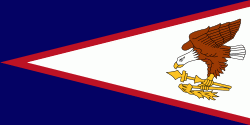Tau (Ta'u County)
Taʻū is the largest island in the Manuʻa Islands and the easternmost volcanic island of the Samoan Islands. Taū is part of American Samoa. In the early 19th century, the island was sometimes called Opoun.
Taū is well known as the site where the American anthropologist Margaret Mead conducted her dissertation research in Samoa in the 1920s, after which she published her findings in a work titled Coming of Age in Samoa. Ta’u also has the highest mountain in American Samoa, Mount Lata, as well as 8.3 sqmi of National Park lands, and 1.5 sqmi of waters separated by some of the tallest sea cliffs in the world.
On the western coast of Taū are the conterminous villages of Lumā and Siufaga, usually referred to jointly as Taū village. The village of Taū has been named the capital of the Manuʻa Islands. Fitiuta is another Taū village, located on the northeast side of the island.
The island is the eroded remnant of a hotspot shield volcano with a caldera complex or collapse feature (Liu Bench) on the south face. The summit of the island, called Lata Mountain, is at an elevation of 931 m, making it the highest point in American Samoa. The last known volcanic eruption in the Manua Islands was in 1866, on the mid-ocean ridge that extends west-northwest towards nearby Ofu-Olosega.
The largest airport in the Manua Islands is on the northeast corner of Taū at Fitiuta. There is also a private airport. A boat harbor is located at Faleāsao at the northwestern corner of the island. A roadway along the north coast connects all of the several inhabited villages between Taū on the west and Fitiuta.
All of the southeastern half of Taū—including all of the rainforest on top of Lata Mountain and within the caldera—the southern shoreline, and associated coral reefs are part of the National Park of American Samoa. The park includes the ancient, sacred site of Saua, considered to be the birthplace of the Polynesian people.
Administratively, the island is divided into three counties: Faleāsao County, Fitiʻuta County, and Taʻū County. Along with the Ofu and Olosega Islands, Taū Island comprises the Manuʻa District of American Samoa. The land area of Taū Island is 44.31 km2 and it had a population of 873 persons as of the 2000 census and of 790 persons in the 2010 census.
In 2000, a subsea volcano 30 mi from Taū Island was discovered by scientists. Rockne Volcano has formed an undersea mountain which is 14000 ft tall. Its peak is 18000 ft below the ocean surface.
Taū is well known as the site where the American anthropologist Margaret Mead conducted her dissertation research in Samoa in the 1920s, after which she published her findings in a work titled Coming of Age in Samoa. Ta’u also has the highest mountain in American Samoa, Mount Lata, as well as 8.3 sqmi of National Park lands, and 1.5 sqmi of waters separated by some of the tallest sea cliffs in the world.
On the western coast of Taū are the conterminous villages of Lumā and Siufaga, usually referred to jointly as Taū village. The village of Taū has been named the capital of the Manuʻa Islands. Fitiuta is another Taū village, located on the northeast side of the island.
The island is the eroded remnant of a hotspot shield volcano with a caldera complex or collapse feature (Liu Bench) on the south face. The summit of the island, called Lata Mountain, is at an elevation of 931 m, making it the highest point in American Samoa. The last known volcanic eruption in the Manua Islands was in 1866, on the mid-ocean ridge that extends west-northwest towards nearby Ofu-Olosega.
The largest airport in the Manua Islands is on the northeast corner of Taū at Fitiuta. There is also a private airport. A boat harbor is located at Faleāsao at the northwestern corner of the island. A roadway along the north coast connects all of the several inhabited villages between Taū on the west and Fitiuta.
All of the southeastern half of Taū—including all of the rainforest on top of Lata Mountain and within the caldera—the southern shoreline, and associated coral reefs are part of the National Park of American Samoa. The park includes the ancient, sacred site of Saua, considered to be the birthplace of the Polynesian people.
Administratively, the island is divided into three counties: Faleāsao County, Fitiʻuta County, and Taʻū County. Along with the Ofu and Olosega Islands, Taū Island comprises the Manuʻa District of American Samoa. The land area of Taū Island is 44.31 km2 and it had a population of 873 persons as of the 2000 census and of 790 persons in the 2010 census.
In 2000, a subsea volcano 30 mi from Taū Island was discovered by scientists. Rockne Volcano has formed an undersea mountain which is 14000 ft tall. Its peak is 18000 ft below the ocean surface.
Map - Tau (Ta'u County)
Map
Country - American_Samoa
 |
 |
American Samoa consists of five main islands and two coral atolls; the largest and most populous island is Tutuila, with the Manuʻa Islands, Rose Atoll and Swains Island also included in the territory. All islands except for Swains Island are part of the Samoan Islands, The total land area is 199 sqkm, slightly more than Washington, D.C. As of 2022, the population of American Samoa is approximately 45,443 people, of whom the vast majority are indigenous ethnic Samoans. Most American Samoans are bilingual and can speak English and Samoan fluently.
Currency / Language
| ISO | Currency | Symbol | Significant figures |
|---|---|---|---|
| USD | United States dollar | $ | 2 |
| ISO | Language |
|---|---|
| EN | English language |
| SM | Samoan language |
| TO | Tongan language |















